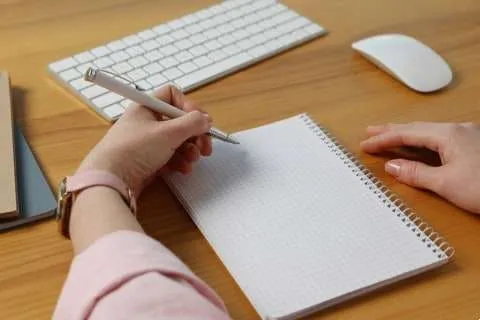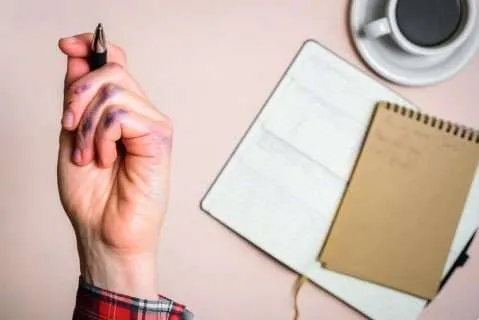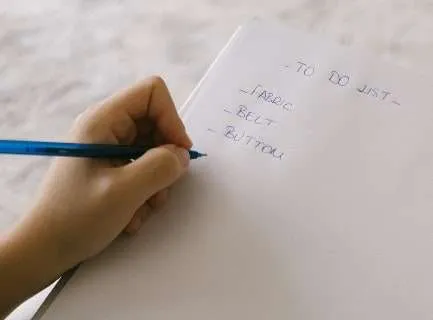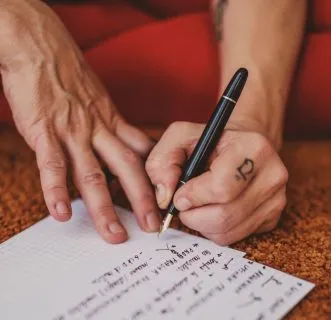Left-handed kids may struggle with writing early in life because of the difficulties that left-handed writing presents. Left-handed hook writing can cause poor ink flow, scratched paper, inky palms, and smudged words. Backward slanting words is also a widespread problem for lefties.
Additionally, left-handers may experience hand fatigue more quickly than right-handers because of the position they tend to use to write. These factors can make writing difficult and frustrating for left-handed kids and even adults. Thankfully, there are ways to help lefties overcome these obstacles with some tips and handwriting help for left handers.
Table of Contents
Left Handed Writing Problems
Why do many lefties have bad handwriting? Some left-handers have problems when they write. Their handwriting might differ from others, and it’s hard to write with the left hand. There are issues we want to avoid, both while learning and in the future.
Left-handed writers often get tired quickly because their hands are working harder than right-handed writers or they may lack proper writing posture. There are a few solutions to these problems, however, and we’ll cover them later in this article. First, let’s list the issues and explain left handed writing vs right handed writing.
Left Handed Hook Writing

One left-handed writing difficulty is hook writing. In this method, the left-hand curves around the page or book in a hook shape with the pen or pencil pointing towards the body instead of away. While right-handers tend to pull the tip away from the paper, left-handers push the tip into the paper. This wouldn’t be an issue if left-handers could write from right to left, like in Arabic, but that’s not the case, unfortunately!
So why do many lefties hook their wrists while writing? That’s because it allows them to more easily see what they’ve already written and to prevent smudging the outside of their palm on still wet ink or dark pencil writing. This is an even bigger problem when a left-hander attempts to do calligraphy!
When children learn to write, most model letters are printed on the left page or in the left margin, while they practice writing to the right of that or on the right page. A hooked hand position lets left-handed children see the model writing better without having to lift their arm from the desk.
Poor Ink Flow
Another left-handed writing difficulty is poor ink flow. This means the ink doesn’t come out of the pen or pencil very smoothly, and it can cause skipped writing where some loops and slants in left handed cursive writing are broken. This is more common for lefties because there’s more friction created while pushing into the paper instead of away from it.
Ballpoint and fountain pens are more notorious for this problem, so felt tip and gel pens may be better if you can’t correct this problem. The only problem is that these types of pens are more likely to create the next issue.
Inky Palm and Smudged Words

Besides poor ink flow, left-handers sometimes have problems with smudged words and inky palms. This happens when the ink gets on their hands and then transfers to the paper.
Right-handers don’t have this problem because you write from left to right with the hand moving away from fresh words just written. The palm doesn’t brush against wet ink at all.
Unless a left-hander slants the paper, writes from underneath the line, and moves the hand towards the body while writing from left to right, the palm will brush against the fresh ink and then drag that inky palm across the page as you continue to write.
Backward Slanting Words

Some left-handers have trouble making their words slant the correct way when they write. Instead of having a slight slant to the right or keeping them erect, some lefties slant their words to the left.
This happens because lefties tend to use the hook style of writing and push the pencil into the paper instead of away from it.
Hand Fatigue

Left-handed writers often get tired more quickly than right-handed writers because their hands are working harder. In addition to the hooked hand formation, lefties also tend to use a quadrupod pen or pencil grip instead of the more traditional tripod grip.
A tripod grip is where you grasp the pencil between your thumb and index finger with the barrel of the pen resting lightly on the middle finger. A quadrupod grip involves holding the pen between your thumb, index, and middle fingers, with the middle finger closer to the tip. The barrel may or may not rest on the ring finger and sometimes the thumb overlaps the index finger. This grip forces the pen to be more erect rather than it being held at a slant.
The quadrupod grip, along with left-handers’ tendency to grip the pen more tightly, can lead to finger fatigue faster. In addition, the hook style of writing leads to bad posture with the left shoulder leaning forward instead of keeping both shoulders back.
Some Pen Nibs Scratch the Paper
Another left-handed writing problem is that some pen nibs can scratch the paper if not angled on the paper correctly, causing friction. Sometimes this can cause too much friction and may even rip the paper, making it difficult to write legibly.
Fountain pens typically come with either an oblique nib or a stub nib. Most oblique nibs are slanted to work for right-handers better unless you choose a left-handed fountain pen nib like the Lamy Safari LH medium nib pen. Even stub nibs that are uniform across the tip need to be held at a certain angle for the ink to flow freely. This may not be an angle that’s comfortable for a lot of lefties. This is also because lefties are used to writing with more pressure than right-handed writers.
How to Teach a Left Handed Child to Write
While adults may have difficulty changing the way they write, when teaching left handed handwriting to children, you’re looking at correcting their posture and the way they’re holding the pen. Having the resources below will help them be more confident in their left hand writing skills and write just as neatly as their right-handed peers. If you have to learn to write with your left hand later in life for a specific reason, these tips will also be helpful.
Correct Left Handed Pencil Grip

If your left-handed child is having problems writing, there are a few things you can do to help. The first thing you should do is make sure they are using the correct pencil grip.
A left-handed child should hold the pencil just as a right-handed one would – between the thumb and the index finger with the barrel resting lightly on the middle finger. This is called a tripod grip and there should be no overlapping of the thumb and fingers while gripping the pencil. The grip should be about 3 cms above the tip and the fingers should not slip down onto the slant of the pen. A tripod grip should feel relaxed and encourage just the right amount of pressure to be placed on the paper.
While the child should be encouraged to get used to the natural feel of the barrel of the pencil, you can also help them along by providing them with a pencil grip that’s texturized but soft to prevent the fingers from slipping. Avoid the type of grips that come with separate finger holders around the pencil barrel holder, as the child may tend to use it as a crutch instead of only learning to write with a proper grip.
For kids and adults who want to try fountain pens, there are additional aspects you’ll need to take into account, so here’s a handy guide on how to write with a fountain pen left-handed.
Left Hand Writing Position and Paper Position
Left-handers should position the notepad or paper to almost align with the left side of their body while also slanting the paper down towards the right. This will help them write from below the line instead of hooking or arching their left hand to write from the side or above.
This practice avoids smudging words and getting ink on their hands and encourages the words to stay erect or slant slightly forward instead of backward.
While getting used to writing this way, you can also make it less frustrating for the child by ensuring that the book spine doesn’t get in their way or the opposite page lays flat. Lefty-friendly notebooks are great for this.
Use the Right Hand to Hold the Paper

Additionally, left-handed writers should use their right hand to hold the paper. This will help them keep the paper still and avoid smudging their words.
Provide Cursive Writing Worksheets for Left Handers
Schools often provide handwriting worksheets to kids where model letters and words are printed on the left hand side of the page or in the left margin. This means that left-handers have to constantly lift their left hand to see the model. Either provide a second copy of the worksheet for the child to place to their right for easy visibility, or provide special worksheets where the model words are printed to the right. Left handed worksheets are as essential in a classroom as left handed scissors for kids.
Position Lefties to the Left of the Class
Lastly, left-handed writers should be positioned to the left of the other students in class. This will help them avoid elbowing into their right-handed classmates if the desks are right next to each other.
Additionally, make sure that the desk has enough space to rest the left arm in between writing as well. Desks with no arm bias are ideal, but if the classroom uses only one-armed desks, make sure to have a few left-handed school desks as well.
Additional Solutions
If left-handed writing problems are causing difficulties in completing assignments or producing legible work, there are a few other solutions that can be tried.
Low Viscosity or Free-flowing Ink
One solution is to try using low viscosity or free-flowing ink. This will help to minimize skipped words and a scratchy paper feeling and just make the writing process less messy.
Rollerball and gell pens are best for these, as they’re water-based instead of oil-based like ballpoint pens and their tips encourage ink flow. We can recommend some of the best pens for left-handers.
Even though fountain pens are notorious for being difficult to use by left-handed people, a few actually work very well once you get the hang of a proper grip and writing style. The best fountain pens for lefties also have nibs that encourage the ink to flow freely and transfer smoothly onto the paper.
Fast Drying Ink

We should also caution that the speed at which ink dries is important too when choosing a pen or refilling a cartridge. Using fast-drying ink will help to avoid smearing and make the writing process less messy, especially if you use an arched or hooked hand that brushes across freshly written words.
There is a diverse range of inks out there. While you would buy your preferred pens or cartridges for roller or gel pens as stated above, you should be more careful if you use fountain pens, as this is where the problem of smearing ink is most common. Here are some of the best fountain pen inks for lefties that you can experiment with.
Ergonomic Pen or Pencil
If left handed writing challenges are causing discomfort in the hand or wrist, one solution is to try using an ergonomic pen or pencil. This can help to reduce the strain on these areas and make writing more comfortable.
There are a few different types of ergonomic pens and pencils that left-handed writers can try, which may help with their writing posture. The Stabilio EASY range of pens and pencils for left-handed kids is very popular.
Using these left handed writing tools will make it easier for a left-handed child to write without developing hand cramps or fatigue.
Related: How to Tie a Tie Left-handed
How to Use Chopsticks Left-Handed
How to Help a Left Handed Child Write Neater
Conclusion
Left handed writing problems can be caused by several things, from hand fatigue to incorrect pencil grip. However, there are a few solutions that can help left-handed students overcome these difficulties and produce legible work. Using low viscosity or free-flowing ink, fast-drying ink, and an ergonomic pen or pencil can all make writing more comfortable and less strenuous for lefties. Additionally, left-handed writers should try a traditional tripod grip and writing style. With a bit of left hand writing practice, writing problems don’t have to impede success!
Reference: Teaching Left-Handers to Write: Handedness Research Institute
